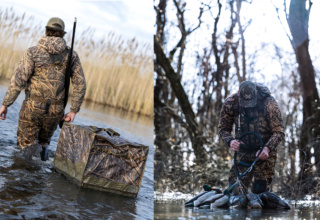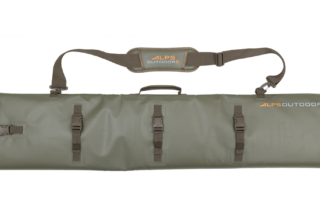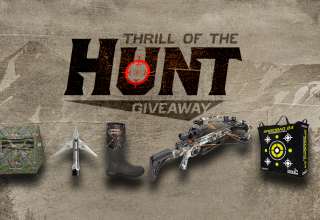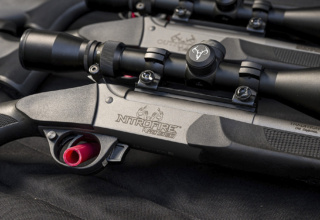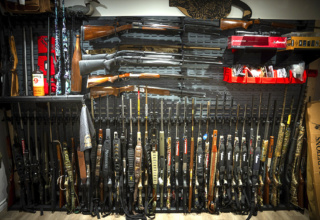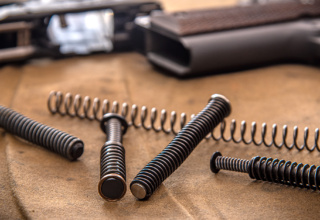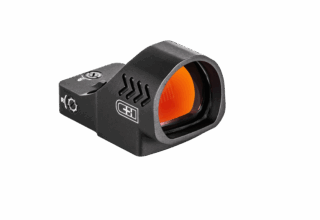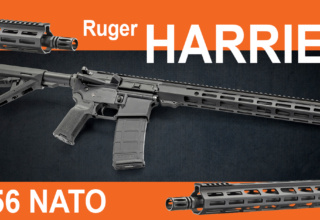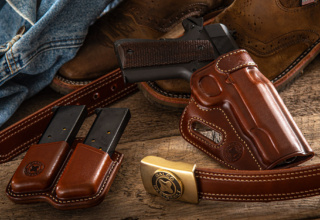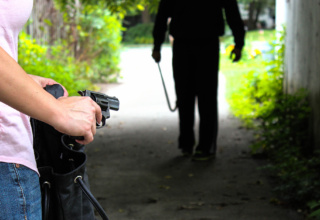A comfortable blind and cooperative geese turned this hunt into something extra special
by Brad Fenson
We headed to the swathed barley field early in the afternoon to set up for an evening hunt. Over 1,000 big honkers had been feeding in the field, along with hundreds of mallards. Our hunting crew was extremely excited at the thought of decoying the real big Canada geese, often tipping the Toledo at over 12 pounds. The farmer had swathed the field several weeks earlier, but constant fall rains had dampened his harvest plans. With swaths in the field, we’d be able to conceal our layout blinds in the uniform and thick parallel lines of grain.
Two of our crew went to work on the blinds, ensuring they were lined up, and stuffed stubble straps with barley straw. The long stems looked like we sewed the blinds together under the cover, blending in perfectly.
The rest of the team went to work setting out decoys. We had four dozen Final Approach Honkers, which were used around the blinds to further conceal shadows and movement. We stretched another ten dozen lessers out over the next four rows of barley, making the perfect landing strip for incoming birds.
We were done early and sat back to wait for the birds, but it didn’t take long for the show to start. Dozens of flocks of big honkers came from the south and staged on a large wetland about 700 yards from the field. The birds would water and eventually come out to feed, and, with any luck, they would stay in the small groups of six to 12 birds.
Normally, I don’t like lying in a layout blind for hours, waiting on the birds, but I had my ALPS OutdoorZ Legend Layout Blind and the zero-gravity chair felt more comfortable than my bed at home. I was boasting about the comfort and several of my hunting partners jumped in to try it firsthand. It was an eye-opener. All the blinds we used blended well into the cover and decoys, but instead of sitting on the ground or leaning against a rigid seat, I floated on air and relaxed.
The geese were getting restless, and the loud honks from behind us turned heads just in time to see two of the big birds headed our way. The wind was coming from behind us, along with the birds, meaning they had to swing around the decoys to come back into the wind to land. The geese looked like 747 aircraft coming in for a landing. The reverberation of their vocal cords made them sound as loud as a train whistle. The deep, guttural honks and moans are why the big ones are often referred to as ‘sky donkeys,’ as they sound like a braying mule or ass.

The duo winged past us on the west, made a wide swing and started to come down the east side of our spread. I was in the end blind, providing me the ideal shot, and when the birds were in range, two of us sat up to shoot. In the commotion of trying to harvest the geese, one of our hunting partners started yelling at the top of his lungs, causing mass confusion on the firing line. I didn’t know whether to duck, shoot, or figure out if there was a problem with one of my hunting partners. The momentary distraction forced me to lower my shotgun to see what the commotion was. I looked over at my buddy on the far end of the shooting line and he was pointing at the birds and yelling, “Quill! It’s a quill!”
The biggest of the two birds was almost completely white on the breast and up part of its neck. The unique coloration is referred to as a “Quill goose,” which is thought to have originated in the Quill Lakes area of Saskatchewan. A Quill is considered a trophy by most waterfowl enthusiasts, and my buddy couldn’t spit the words out quickly enough that he wanted us to target the uniquely colored goose.
I immediately lifted my shotgun, found the huge honker, swung my shotgun out in front of it and unleashed a pattern of Federal Black Cloud TSS. I was happy to have the heavyweight ammunition with the additional knockdown power. I could see the pellets ripping into the bird, and as it tried to escape, it quickly lost altitude and crashed into the trees on the edge of the field. The race was on to retrieve the downed prize and have a closer look.
The hunting crew gathered in awe of the incredible size and unique color of the bird. It was one of the biggest honkers I’d ever seen and the lack of pigment in the feathers, and even the bottom of the bird’s feet, made it a one-of-a-kind reward. The sound of incoming birds broke up the Quill party and we jumped back into our blinds to face the next flock.
The big honkers flew for close to two hours, providing plenty of gunning and allowing us to stack up the ducks and geese. We rearranged decoys to create a spot where birds could cut through the spread for a quicker landing, and it worked. Several flocks were backpedaling wings with feet splayed out to find the ground when the command to shoot came.
We laid out the birds and gathered for photos with the setting sun as our background. It was time to pick up the gear.
ALPS OutdoorZ Legend Layout Blind
The Legend Layout Blind comes fully assembled and ready to hunt. The tarpaulin floor helps trap in heat and insulates the hunter from wet or uncomfortable ground. The zero-gravity chair not only keeps you off the ground but allows you to maintain a low profile. The outer material of the blind is durable, camouflaged, and is fitted with stubble straps to weave cover onto the blind. The unit has backpack carry straps, zippered flag doors, a padded headrest, and rear zippered door for access to storage. The doors are hinged for quick closing and spring open when its time to shoot.
Federal Black Cloud TSS
Black Cloud TSS is loaded with a blend of FLITESTOPPER Steel pellets and 18 g/cc Tungsten Super Shot. The TSS pellets are 56 percent higher density than lead and more than double the density of steel, providing hard-hitting penetration at longer ranges. Each shotshell consists of 60 percent No. 7 or 9 TSS pellets and 40 percent FLITESTOPPER Steel BB or No. 3, producing patterns that are dense and deadly.
Final Approach Honker
Final Approach has HD Full Body Honkers molded with softer plastics for durability and paint retention. The heads are flocked for realism and to beat any moisture or frost when hunting. A box of six includes one sentry, one rester, and four feeders.









